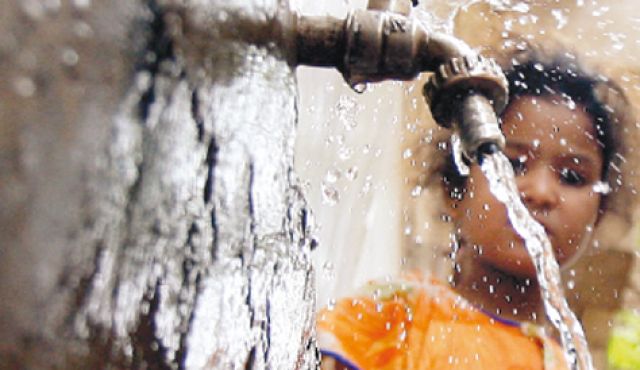By Sara Schwartz
Masters Candidate in Water Resources Science and Management
Yale School of Forestry and Environmental Studies
As of 2015, 1 in 10 people did not have access to safe drinking water and more people had cell phones than toilets. The global population is expected to reach over nine billion by 2050 with an estimated 66% living in cities; the UN predicts over the same period about 4 billion people will be living in water stressed areas. Furthermore, a World Health Organization (WHO) study found over 80% of residents in cities monitoring air pollution are exposed to air quality below WHO standards, and in China alone 90% of cities have polluted groundwater.
Cities are a major engine of national and global growth. The recently adopted Sustainable Development Goals include the creation of inclusive, safe, resilient, cities. The United Nations (UN) Habitat III Conference on sustainable urban development more specifically includes goals for the provisioning of basic services and equitable living.
However achieving this vision must include effective urban governance. A lack of publicly distributed information on pollution exacerbates these issues and threatens this vision of sustainable and equitable living. The Environmental Democracy Index’s (EDI) assessment of 70 countries found that 42% have little or no environmental information available to the public. At the same time, 59 countries recognize this right in their constitution and over 100 countries have a Right to Information Law.
The Access Initiative (TAI) teamed with local civil society partners to improve these statistics. Together they established a project called Strengthening the Right to Information for People and the Environment (STRIPE) and are working on a toolkit to help communities exercise their right to pollution information. STRIPE specifically focuses on empowering civil society and local people to utilize their legal right to obtain and use environmental and public health information and participate more effectively in environmental decision making forums. A draft toolkit has been utilized by rural communities in Indonesia, Mongolia, Thailand, and Jamaica. The toolkit provides civil society organizations and activists practical guidance on how to use their right to information to evaluate the quality and quantity of air and water pollution released into their environment and community. It is scheduled to be released in late 2016.
With more than half of the world’s population living in cities, however, we must consider how access to information and public participation tools can be best applied to urban areas — not only because majority of the world is city-bound but because pollution tends to be prevalent in urban areas.
Every city’s context is as unique as the maze of buildings and people it encompasses. An urban campaign must recognize these difference while still being widely applicable. There are a few starting points to achieve this goal – with water resrouces used as an example to provide context.
Mapping the Challenges
Mapping the topography and locations of vulnerable populations, infrastructure, and pollution sources can visually link populations in need to pollution challenges. These maps can indicate if drinking water infrastructure is present and functioning in all areas of the city and if poor residents or informal communities live in floodplains. Understanding these connections enables STRIPE partners to organize and prioritize pollution and access to information challenges. Similar mapping tools such as EJSCREEN and EJOLT are already available for cities across the United States and around the world.
Stakeholders
Stakeholders are critical to the STRIPE process. Cities typically have high population densities compared to rural areas. As a result there are more stakeholders to engage in order to receive and deliver information. Urban communities may represent people of different socioeconomic, ethnic, cultural, demographic, physical, and mental backgrounds and abilities. With this diversity comes the need to provide pollution information in multiple languages, different formats, and through various communication methods. Additionally, multiple stakeholders may be responsible for overseeing different aspects of a city’s water. Clarifying stakeholder roles can help ensure their effectiveness and improve coordination and accountability.
Holistic Thinking
Integrated management and systems thinking should be a central theme to pollution information access initiatives in cities. Cities are often faced with many challenges outside of pollution such as civil unrest, food shortages, and natural disasters. Seeing how pollution and access to information fit into the bigger picture may yield better results. Additionally the involvement or creation of a basin-wide water management organization is needed to assess how the city’s water challenges connect at the watershed level.
To illustrate how these ideas apply to an urban context, consider Jakarta, Indonesia. Jakarta suffers from frequent, extreme floods and a lack of widespread drinking water and wastewater services. Many poor residents live on floodbanks because of the availability of cheap or free land. The sole wastewater treatment plant is located closest to wealthy homes while approximately 95% of the city has no wastewater treatment. The city is comprised of approximately 10 million people with over 14,000 people per square kilometer and seven ethnic groups. A holistic approach to Jakarta’s water challenges is needed not only because of interconnections between flooding, saltwater intrusion, and polluted water sources but also because of the interconnections between poverty, rapid urbanization, lack of infrastructure, and a lack of awareness and access to pollution information.
Jakarta is not alone in learning to manage these multi-faceted challenges. From Delhi to Rio, cities around the world are coping with pollution, population rise, and a myriad of additional challenges. As cities work towards solutions they must inform residents of environmental pollution and provide opportunities for participation in pollution governance. This task can be especially difficult in cities with large and diverse populations. An urban STRIPE toolkit is just one way to help communities access pollution information and increase the dissemination of this information. While it is not the responsibility of citizens to push for this reform, it is their passion and call for action that can sometimes have the biggest impact.
